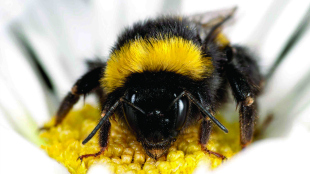Nature:伦敦大学皇家学院指出蜜蜂传染病亦能感染大黄蜂
高效授粉对于粮食生产和生态系统可持续发展来说都至关重要,有证据表明新出现的传染病造成一些重要昆虫授粉者种群数量下降。

Nature:伦敦大学皇家学院指出蜜蜂传染病亦能感染大黄蜂
已知“变形翅膀病毒”(DWV)是导致蜜蜂畸形和缩短它们寿命的罪魁祸首。为了揭示其在英国野生熊蜂产生的影响,伦敦大学皇家霍洛威学院生态学家马克布朗,和他的同事在实验室研究受感染的野生熊蜂,大黄蜂,与DWV的潜在影响。他们发现,该患病熊蜂寿命减少了六天。
这项研究结合实验室感染实验和野外研究显示了两个严重的蜜蜂(Apis melLifera)病原体对于一种野生授粉昆虫“大黄蜂”(Bombus terrestris)的感染能力。
“研究结果表明蜜蜂种群管理,与高密度病原体,都有可能对野生传粉着产生威胁,”没有参与这项研究、德国霍恩 - 诺伊恩多夫蜜蜂研究所研究员Elke GENErsch说。
虽然研究结果证实了蜜蜂病原体传播导致野生授粉昆虫“大黄蜂”数量减少,但还明确这个传播机制。
以往的研究表明,野生熊蜂能够携带DWV。布朗的研究小组横跨英国马恩岛进行了一次大调查,比较蜜蜂和大黄蜂的患病率。大约三分之一的蜜蜂感染了DWV和11%的大黄蜂感染DWV。映射出这种疾病是目前在每一个物种呈重叠分布,表明有可能是两个物种之间的疾病传播。
来自英国各地的数据显示,DWV和微孢子虫寄生虫Nosema ceranae 在两种类型的授粉者中存在“共局部化”现象,蜜蜂病对大黄蜂也有传染性。这项工作表明,野生授粉者种群可能面临风险,而且与人工管理的蜜蜂种群不同的是,它们没有因为养蜂人采取干预措施而受到保护。野生授粉者的这种损失会显著降低作物授粉效率。
虽然这项研究无法确切说明DWV是从蜜蜂传输到大黄蜂,尽管蜜蜂的发病率较高。“但这也是为什么我们真的认为这是一传播方向,”该研究的主要作者、奥地利科学与技术研究所马蒂亚斯·弗斯特说。
原文摘要:
Disease associations between honeybees and bumblebees as a threat to wild pollinators
M. A. Fürst, D. P. McMahon, J. L. Osborne, R. J. Paxton & M. J. F. Brown
Emerging infectious diseases (EIDs) pose a risk to human welfare, both directly1 and indirectly, by affecting managed livestock and wildlife that provide valuable resources and ecosystem services, such as the pollination of crops. Honeybees (Apis mellifera), the prevailing managed insect crop pollinator, suffer from a range of emerging and exotic high-impact pathogens, and population maintenance requires active management by beekeepers to control them. Wild pollinators such as bumblebees (Bombus spp.) are in global decline, one cause of which may be pathogen spillover from managed pollinators like honeybees or commercial colonies of bumblebees. Here we use a combination of infection experiments and landscape-scale field data to show that honeybee EIDs are indeed widespread infectious agents within the pollinator assemblage. The prevalence of deformed wing virus (DWV) and the exotic parasite Nosema ceranae in honeybees and bumblebees is linked; as honeybees have higher DWV prevalence, and sympatric bumblebees and honeybees are infected by the same DWV strains, Apis is the likely source of at least one major EID in wild pollinators. Lessons learned from vertebrates highlight the need for increased pathogen control in managed bee species to maintain wild pollinators, as declines in native pollinators may be caused by interspecies pathogen transmission originating from managed pollinators.

